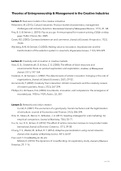Theories of Entrepreneurship & Management in the Creative Industries
Lecture 1: Business models in the creative industries
Peltoniemi, M. (2015), Cultural industries: Product–market characteristics, management
challenges and industry dynamics. International Journal of Management Reviews, 17(1), 41- 68.
Frey, B. S. & Steiner, L. (2010): Pay as you go: A new proposal for museum pricing, CESifo working
paper, Public Choice, No. 3045.
Caves, R.E. (2003). Contracts between art and commerce. Journal of Economic Perspectives, 17(2),
73-83.
Wijnberg, N.M. & Gemser, G (2000). Adding value to innovation: Impressionism and the
transformation of the selection system in visual arts, Organization Science, 11(3), 323-329.
Lecture 2: Creativity and innovation in creative markets
Voss, G. B., Sirdeshmukh, D. & Voss, Z. G. (2008). The effects of slack resources and
environmental threat on product exploration and exploitation, Academy of Management
Journal, 51(1), 147-164.
Castaner, X., & Campos, L. (2002). The determinants of artistic innovation: bringing in the role of
organizations, Journal of Cultural Economics, 26(1), 29-52.
Accominotti, F. (2009). Creativity from interaction: Artistic movements and the creativity careers
of modern painters, Poetics, 37(3), 267-294.
Phillips, D.J. & Owens, D.A. (2004). Incumbents, innovation, and competence: the emergence of
recorded jazz, 1920 to 1929, Poetics, 32, 281–
Lecture 3: Networks and value creation
Currid, E. (2007). The economics of a good party: Social mechanics and the legitimization
of art/culture. Journal of Economics and Finance, 31(3), 386-394.
Hinz, O., Skiera, B., Barrot, C., & Becker, J. U. (2011). Seeding strategies for viral marketing: An
empirical comparison. Journal of Marketing, 75(6), 55-71.
Cui, G., Lui, H. K., & Guo, X. (2012). The effect of online consumer reviews on new product sales.
International Journal of Electronic Commerce, 17(1), 39-58.
Chung, T. S., Wedel, M., & Rust, R. T. (2016). Adaptive personalization using social networks.
Journal of the Academy of Marketing Science, 44(1), 66-87
Case week 3: Crowdfunding for the arts
Mollick, E. (2014). The dynamics of crowdfunding: An exploratory study. Journal of Business
Venturing, 29, 1-16.
1 of 112
, Lecture 4: Fads and fashions
Salganik, M.J & Watts, D.J. (2008) Leading the herd astray: An experimental study of self-
ful lling prophecies in an arti cial cultural market, Social Psychology Quarterly, 71, 4: 338-
355.
De Groot, J.; Kackovic, M. & Wijnberg, N.M. (2020) Cultural Consumption as a Sign of Status in
the Workplace, research paper (there is a link to the pdf of this paper in the module of this
week's literature on Canvas).
Yoganarasimhan, H. (2012) Cloak or aunt? The fashion dilemma. Marketing Science, 13(1), 74-95.
Gemser, G. & Wijnberg, N.M. (2001) Effects of reputational sanctions and inter- rm linkages on
competitive imitation, Organization Studies, 22(4), 563-591.
Lecture 5: Authenticity and reality
Wei, J. (2012). Dealing with reality: Market demands, artistic integrity, and identity work in
reality television production, Poetics, 40(5), 444-466.
Beverland, M.B. & Farrely F.J. (2009). The quest for authenticity in consumption: Consumers’
purposive choice of authentic cues to shape experienced outcomes, Journal of Business
Research, 36, 838-856.
Ouellet, J.F., Savard, M.A., Colbert, F. (2008). The personality of performing art venues:
Developing a measurement scale, International Journal of Arts Management, 10(3), 49-59.
Mol, J.M. & Wijnberg, N.M. (2007). Competition, selection and rock & roll: the economics of
payola and authenticity. Journal of Economic Issues, 41(3), pp. 701-714.
Lecture 6: Release strategies and recommender systems
Krider, R. E., & Weinberg, C. B. (1998). Competitive dynamics and the introduction of new
products: The motion picture timing game. Journal of Marketing Research, 35(1), 1-15.
Elberse, A., & Eliashberg, J. (2003). Demand and supply dynamics for sequentially released
products in international markets: The case of motion pictures. Marketing Science, 22(3),
329- 354.
Koren, Y., Bell, R., & Volinsky, C. (2009). Matrix factorization techniques for recommender
systems. Computer, 42(8), 30-37.
Aguiar, L., & Waldfogel, J. (2018). Platforms, promotion, and product discovery: Evidence from
Spotify playlists (No. w24713). National Bureau of Economic Research, 1-42.
Knox, G., & Datta, H. (2020). Streaming services and the homogenization of music consumption.
Working paper (downloaded July 3, 2020)
2 of 112
fi
fi fl fi




